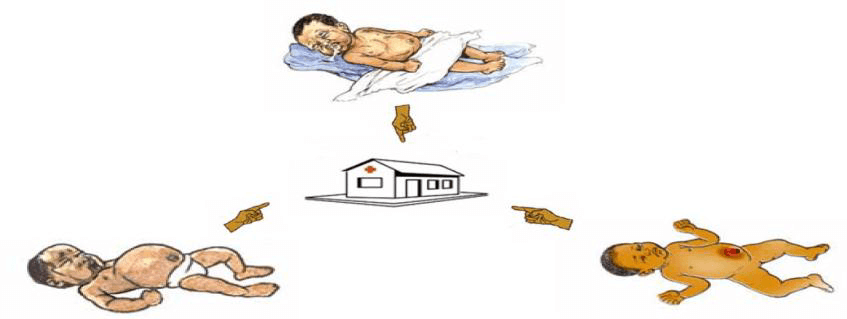
The newborn baby should also be evaluated for any danger signs within six hours after delivery.
Not at all or inadequate breastfeeding: This is commonly seen in preterm, very low birth weight, asphyxiated, and sick babies due to some other infectious diseases or any other health problems. The baby may not breastfeed (fail to suck the breast) or suck minimally. On the other hand, the mother's breast may not produce enough amount of milk even though the baby is sucking well. If the problem is from the mother, you have to encourage the mother to breastfed her baby, because, sucking by itself will increase milk production. Preterm, very low birth weight, asphyxiated, and sick babies should be referred as soon as possible; or the baby may die from hypoglycemia (decrease of glucose in the blood).
Neonatal Jaundice: This is defined as the yellowish discoloration of the baby's skin. It can occur within 24 hr of birth or when the baby is two weeks old. In both cases, urgent referral of the baby to the nearest health centre or hospital is needed.
Fever, repeated vomiting, swollen abdomen, or no stool after 24 hours: If the body temperature of the baby exceeds 37.5ºC it is called fever. It is the indicator of the presence of infection. Repeated vomiting, swollen abdomen, and inability to pass stools after 24 hours may indicate obstruction of the Gastrointestinal at some point. Since conditions are also life-threatening conditions for the baby, you should have to refer the baby as soon as possible.
Hypothermia:A condition in which the body temperature of the baby falls below 35ºC is called hypothermia. This can occur when the baby is transformed from the intrauterine life (where he adopted the maternal body temperature of 37ºC) to the external environment (where the temperature is 25ºC or room temperature) he will lose heat to the external environment. At this time the baby will feel cold and start to shiver. So, as soon as you examine this condition on the baby; put him in skin-to-skin contact with his mother and wrap them together with a warm blanket. Put the small cup on baby's head. If the baby's body temperature fails to show improvement, refer the baby to the higher health facilities for further investigation and management.

Respiratory Distress: If the breathing rate of the baby is greater than 60 breaths per minute, it is called Respiratory distress. This can occur when the baby swallows the fluid which helps him to float within the uterus to prevent him from any mechanical trauma called the amniotic fluid. Other than fast breathing, respiratory distress is characterised by sinking of the ribs (getting inward) when the baby struggles to breathe, and this is called, chest in-drawing. The lips become blue due to a shortage of oxygen (which is called, cyanosis) and fast heart rate greater than 160 beats/minute.
Bleeding from the umbilical stump or another site: If the baby's umbilicus is not given attention and tied lose, the baby may die of bleeding. Because of the total amount of blood that is found in newborn's body is the only 240ml. So, loss of small amount of blood will cause shock on the baby. Bleeding may occur in two styles; directly from the newly cut umbilical stump area or through the anus indicating bleeding from the small intestine or any part of the alimentary canal.

Red swollen eyelids which may or may not have pussy discharge: This is a condition in which the baby's eye may be infected with sexually transmitted infection causing bacteria called gonococcus gonorrhoea when the baby pass through the vaginal canal during delivery. But this will occur only if the mother was infected with STI. Since the use of TTC eye ointment is one of the components of essential newborn care, it should be added into the eyes of every new born. If the eye gets ill after you have added TTC eye ointment, refer the baby urgently to the nearby health centre.Do you think it is necessary to know those danger signs about maternal and child health? If your answer is yes, why? Explain it by discussing with your friend beside you.
Do you think it is necessary to know those danger signs about maternal and child health? If your answer is yes, why?
The answer to the first question is "yes it is necessary." Because unless you can identify those danger signs, which may also be the causes of maternal and neonatal mortality during the antenatal period, you can't save the lives of mothers and children of your community. So try to remember those danger signs clearly to give good postnatal care both at the health post and the community level.